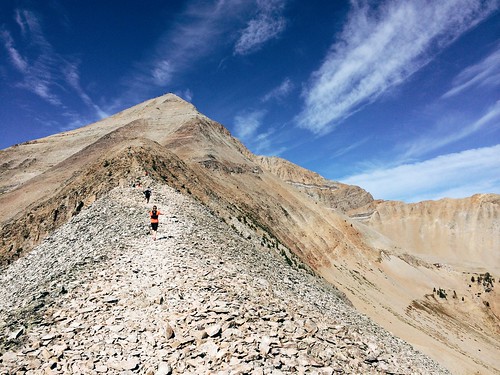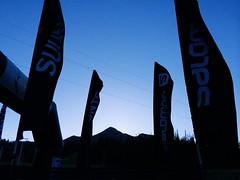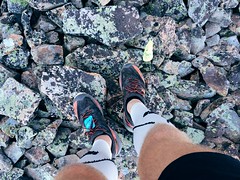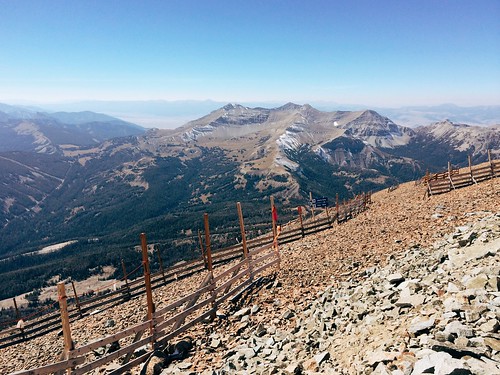
After starting summer with my longest run to date, I finished the season with my highest and hardest run: The Rut 50K, with 11,000 feet of elevation gain over the 11,166-foot summit of Lone Peak.
Organized by Missoula's Runner's Edge store, the race took place in mid-September at Big Sky Resort, between Bozeman and Yellowstone National Park. Being the final ultramarathon in the 2014 Skyrunner World Series, some of the biggest names in the sport were there: Kilian Jornet, Sage Canaday, Emelie Forsberg, Kasie Enman and others. (I can now add "skyrunner" to my bio, apparently; for a primer, see this Trail Runner magazine article and video.)
We arrived the day before the 50K and settled into the condo we rented before visiting with friends at the start/finish area, attending my race meeting and Jen's aid station meeting, then eating dinner. On the way back to the condo to go to bed, I noticed the light atop Lone Peak appeared as if it were a star.

Early the next morning, we walked to the start and Jen departed with her aid station crew. After watching the first wave of runners get underway at 6 a.m., it was my turn five minutes later.
Starting to a pre-dawn elk bugle, the second wave of streaming headlamps made its way gradually uphill. I soon found myself among a handful of familiar voices in as we slowly made our way uphill in a line. At the top of the first climb near 2 miles, the sun had risen enough to see the footing.
The next 5 1/2 miles were downhill to the Madison Village, eventually running on trails and ramps between rows of houses. Turning uphill again, the course steadily rose for 5 miles past the first aid station at 7 1/2 miles and into the forest.
After another couple of short downhill stretches, I left the trees at about 14 miles and arrived at the first major climb for the day: Headwaters Ridge. Here, the course left the trail and scrambled steeply up the scree, rising a little more than 1,000 feet in a little less than 3/4 mile. At the top, a quick descent using a via ferrata line led to the narrow ridgeline and a fast run down 1,700 feet over 1 1/2 miles and into the forest. A couple of patches of snow left from a storm earlier in the week clung to the rocks, and careful footing was required as a misstep could send you tumbling downhill.

Over then next 2 miles, the course climbed again into a sun-baked basin where the 18-mile aid station sat at the Lone Peak tram dock. Here, a small crew of Missoulians - including Jen - helped with drop bags, food and fluids. After refilling my hydration pack and eating some, I headed toward the start of Bonecrusher Ridge. In the end, Jen and the others would make it to the finish line before me.
A mile back down from the tram dock then slightly uphill, the course turned onto Bonecrusher Ridge, the highest climb of the day. In about 1 1/3 miles, the trail climbed 2,000 feet out of the trees and up the hot, rocky ridge - the tram dock directly below a nearly vertical drop to the side. On the steepest section near the top, it wasn't unusual to be on all fours in places. At the summit, it was nice to take another short break at the aid station to eat and catch my breath before continuing.

The 2,500-foot descent over the next 1 3/4 miles was the roughest part of the race on my the feet as the course took us over plate-sized slabs of rock that would shift underfoot on occasion. At the bottom, I stopped briefly to empty my shoes of gravel as well.
Back in the trees, the trail rain along the border of Big Sky Resort and the exclusive Yellowstone Club, dropping for a mile then climbing almost half a mile past one of the large homes. After two more miles of downhill, the course reached thicker forest and a 1-mile climb up muddy trails and over mountain bike ramps, occasionally aided by ropes. Near 27 1/2 miles, the trail reached the final aid station.
From there, the last 4 1/2 miles of the course were mostly downhill, crossing ski slopes, then rising slightly through the forest again. After passing behind one of the resort's large hotels, I arrived at the finish, covering about 32 miles in 9 hours.
A few post-race notes:
Slowest mile: Mile 21, with 1,424 feet of elevation gain, took 50:13. It also likely included some time at the Lone Peak aid station.
Fastest mile: Mile 4 - in the first downhill section - took 8:32.
Food: The spread wasn't as expansive as at the Bighorn Mountain Wild and Scenic Trail Run (see notes), but the mini dill pickles atop Lone Peak were delicious.
They meant well: As a spectator, what you say might not be interpreted how you intend. "You're almost there - just around the corner," said one spectator. To me, those words of encouragement indicate the finish is nearby, not a ridge called Bonecrusher. "Just eight little hills to go," said another spectator in the last couple of miles. Nothing was "little" at that point.
The "medal": This being The Rut, the elk hide finisher's "medal" was a unique touch - just have to keep my dog from getting it.

All in all, it was a great experience - and a fun way to start a weeklong vacation to Yellowstone National Park. And while it was a difficult race, I'll probably return!